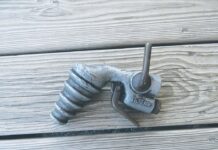A coal-fired power plant seems an unlikely location for a wildlife refuge, but that’s exactly what I found on the second Sunday in July. Monty Mason, a friend and a heavy equipment operator at the AEP Kammer-Mitchell Plant south of Moundsville, W.Va., invited me to join him for a few hours in a blind near an active osprey nest.
Monty had called me a few weeks earlier to set up the visit, and from past experience, I knew the trip would be worthwhile. Monty is an avid outdoorsman and a keen observer of wildlife. Last year he told me a pair of ospreys built a nest, but no eggs ever appeared. The ospreys returned in April and began building a nest shortly thereafter.
Foundation
Though he and some other conservation-minded workers had erected a nesting platform nearby several years ago, the ospreys chose to build their nest on top of a coal barge unloader on the bank of the Ohio River. The top of the 60-foot tall apparatus consists of a set of intersecting steel beams forming the shape of a star. It’s a solid foundation for a nest made of sticks and branches measuring about 5 feet across.
Plant manager Wayne Irons shares Mason’s interest in nature and the outdoors and has encouraged Monty’s conservation efforts.
“We always have lots of great blue herons around, especially on the island just south of the plant, but this osprey nest has caused quite a stir,” he told me. “I find it amazing they built a nest on a coal barge unloader because it really vibrates when being used,” Irons continued.
Such adaptability reminds me of robins and phoebes that nest on a porch where doors open and close all day long. Repeated exposure to usually disturbing events often leads animals to ignore such disturbances.
Scolding
As Monty and I climbed the ladder to the blind, the adult ospreys flew nearby and scolded us repeatedly. About five minutes after we settled into the blind, one adult (presumably the female) returned to the nest.
The blind is about 50 feet from the nest and with binoculars we could barely see the cryptically marked backs of the two large nestlings. For 40 minutes the females stood guard and the nestlings never moved.
Monty began to worry that they had died, when suddenly one, and then the other, raised its head. The juveniles’ orange irises were distinctive and in contrast to the adults’ yellow eyes. I also noted a patch of golden feathers on the napes of the juveniles’ necks.
While we waited for the male to bring a fish to the nest, Monty explained that weeks earlier he had watched the adults gather nesting material. They snatched many of the branches off the ground, but he also saw them break dead branches off both dead and live trees.
“They flew by, grabbed a branch with their talons, and snapped it off — in flight,” he explained.
I knew chimney swifts collected much smaller twigs in flight, but I didn’t know ospreys did it, too.
Dinner
Finally, after about 45 minutes, the male returned to the nest with a fish and the female tore off small pieces and offered them to the nestlings. The meal lasted about 15 minutes.
Then the nestlings stood up, stretched, flapped their wings repeatedly, and walked around the nest before settling down for another nap.
After leaving the blind, Monty gave me a quick tour of the plant grounds. He showed me an active colony of bank swallows whose nesting burrows peppered a mountain of waste ash. Kestrels nested in many of the plants buildings, killdeer used the flat gravel parking areas, and bluebirds and wood ducks occupied some of the nest boxes Monty and others had provided.
Canada geese wandered freely around the plant and while driving by on Route 2, I’ve often seen flocks of turkeys feeding on plant property.
A power plant is far from pristine habitat, but when just a few people take time to provide key bits of habitat, even an industrial site can provide an impressive place to watch wildlife.












